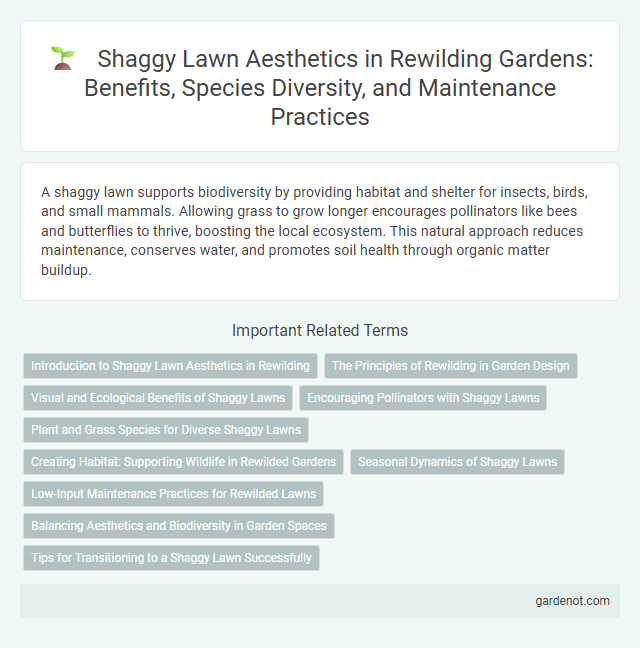A shaggy lawn supports biodiversity by providing habitat and shelter for insects, birds, and small mammals. Allowing grass to grow longer encourages pollinators like bees and butterflies to thrive, boosting the local ecosystem. This natural approach reduces maintenance, conserves water, and promotes soil health through organic matter buildup.
Introduction to Shaggy Lawn Aesthetics in Rewilding
Shaggy lawns in rewilding projects prioritize natural growth patterns, encouraging biodiversity and providing habitats for pollinators and small wildlife. These unmanaged grassy areas support native plant species and improve soil health by minimizing human intervention and promoting ecological balance. The aesthetic appeal lies in their textured, untrimmed appearance, which contrasts with traditional manicured lawns and fosters a sense of wildness and environmental sustainability.
The Principles of Rewilding in Garden Design
Shaggy lawns embody the principles of rewilding by promoting biodiversity and natural processes within garden design. Allowing grasses and native plants to grow freely supports pollinators, improves soil health, and creates habitats for various wildlife. This approach reduces maintenance and chemical inputs, fostering resilient and self-sustaining ecosystems.
Visual and Ecological Benefits of Shaggy Lawns
Shaggy lawns, characterized by their uneven, natural growth, enhance biodiversity by providing habitats for pollinators and small wildlife. Their dense, textured vegetation improves soil health and reduces erosion while offering a visually appealing, meandering aesthetic that mimics natural landscapes. This approach supports ecological resilience by fostering native plant species and encouraging a balanced ecosystem.
Encouraging Pollinators with Shaggy Lawns
Shaggy lawns create an ideal habitat for pollinators by offering diverse native wildflowers and longer grass that provides shelter and food sources. This naturalistic approach boosts biodiversity, supporting bees, butterflies, and other essential pollinating insects. Enhancing pollinator populations through shaggy lawns contributes significantly to ecosystem health and the flourishing of local flora.
Plant and Grass Species for Diverse Shaggy Lawns
Shaggy lawns thrive with a mix of native plant and grass species such as fine fescues, bentgrasses, clovers, and creeping thyme, which create a visually diverse and ecologically rich habitat. Incorporating drought-tolerant and pollinator-friendly plants like black-eyed susan, yarrow, and wild lupine enhances biodiversity and supports local wildlife. This species diversity not only improves soil health but also reduces the need for fertilizers and irrigation, promoting sustainable lawn management.
Creating Habitat: Supporting Wildlife in Rewilded Gardens
Shaggy lawns, characterized by longer, uneven grass and native wildflowers, create essential habitats that support a diverse range of pollinators, insects, and small mammals. These naturalistic spaces provide shelter, breeding grounds, and food sources, fostering biodiversity within rewilded gardens. Encouraging shaggy lawns promotes ecological balance and enhances urban wildlife corridors.
Seasonal Dynamics of Shaggy Lawns
Shaggy lawns exhibit distinct seasonal dynamics, characterized by rapid growth and increased biodiversity during spring and summer months, when warm temperatures and longer daylight hours promote flourishing wildflowers and grasses. In autumn, these lawns undergo senescence, with seed heads and dried vegetation providing crucial habitats for insects and small wildlife. Winter dormancy prepares shaggy lawns for the following growing season, maintaining soil health and supporting ecosystem resilience through varied organic matter decomposition.
Low-Input Maintenance Practices for Rewilded Lawns
Shaggy lawns thrive under low-input maintenance practices by minimizing mowing frequency, allowing native grasses and wildflowers to flourish naturally. Emphasizing biodiversity, these lawns benefit from reduced fertilizer and pesticide use, promoting resilient ecosystems and supporting pollinators like bees and butterflies. Implementing seasonal mowing only in late summer preserves seed heads and encourages diverse plant growth, enhancing habitat value in rewilded spaces.
Balancing Aesthetics and Biodiversity in Garden Spaces
A shaggy lawn enhances biodiversity by providing habitat for pollinators, insects, and small wildlife, supporting ecological balance in garden spaces. Maintaining varied grass heights encourages native flora growth while preserving an aesthetically pleasing, natural look that contrasts sharply with uniform, manicured lawns. Gardeners achieve harmony by selectively mowing and integrating wildflower patches, promoting both environmental health and visual diversity.
Tips for Transitioning to a Shaggy Lawn Successfully
Promote biodiversity by reducing mowing frequency and allowing native grasses and wildflowers to flourish in your shaggy lawn. Introduce mulch or compost to improve soil health, creating an ideal environment for diverse plant species. Monitor and manage invasive weeds early to maintain ecological balance during the transition.
Shaggy lawn Infographic

 gardenot.com
gardenot.com